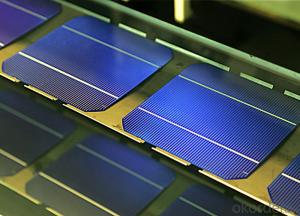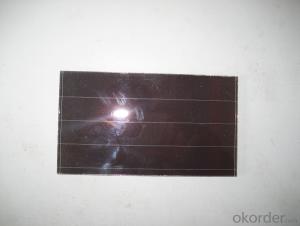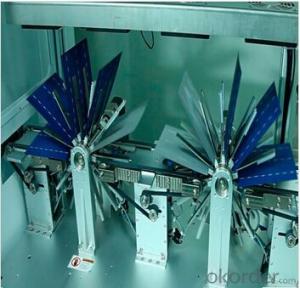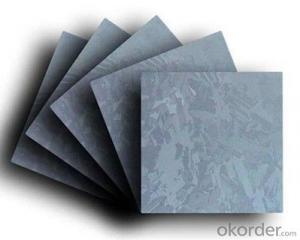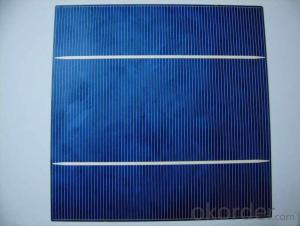Solar Cell High Quality A Grade Cell Polyrystalline 5v 17.8%
- Loading Port:
- Shanghai
- Payment Terms:
- TT OR LC
- Min Order Qty:
- 1000 pc
- Supply Capability:
- 100000 pc/month
OKorder Service Pledge
OKorder Financial Service
You Might Also Like
Specifications
hot sale solar cell
1.16.8%~18.25% high efficiency
2.100% checked quality
3.ISO9001/ISO14001/TUV/CE/UL
4.stable performance
We can offer you the best quality products and services, don't miss !
POLY6'(156*156)
Polycrystalline Silicon Solar cell
Physical Characteristics
Dimension: 156mm×156mm±0.5mm
Diagonal: 220mm±0.5mm
Thickness(Si): 200±20 μm
Front(-) Back(+)
Blue anti-reflecting coating (silicon nitride); Aluminum back surface field;
1.5mm wide bus bars; 2.0mm wide soldering pads;
Distance between bus bars: 51mm . Distance between bus bars :51mm .
Electrical Characteristics
Efficiency(%) | 18.00 | 17.80 | 17.60 | 17.40 | 17.20 | 16.80 | 16.60 | 16.40 | 16.20 | 16.00 | 15.80 | 15.60 |
Pmpp(W) | 4.33 | 4.29 | 4.24 | 4.19 | 4.14 | 4.09 | 4.04 | 3.99 | 3.94 | 3.90 | 3.86 | 3.82 |
Umpp(V) | 0.530 | 0.527 | 0.524 | 0.521 | 0.518 | 0.516 | 0.514 | 0.511 | 0.509 | 0.506 | 0.503 | 0.501 |
Impp(A) | 8.159 | 8.126 | 8.081 | 8.035 | 7.990 | 7.938 | 7.876 | 7.813 | 7.754 | 7.698 | 7.642 | 7.586 |
Uoc(V) | 0.633 | 0.631 | 0.628 | 0.625 | 0.623 | 0.620 | 0.618 | 0.617 | 0.615 | 0.613 | 0.611 | 0.609 |
Isc(A) | 8.709 | 8.677 | 8.629 | 8.578 | 8.531 | 8.478 | 8.419 | 8.356 | 8.289 | 8.220 | 8.151 | 8.083 |
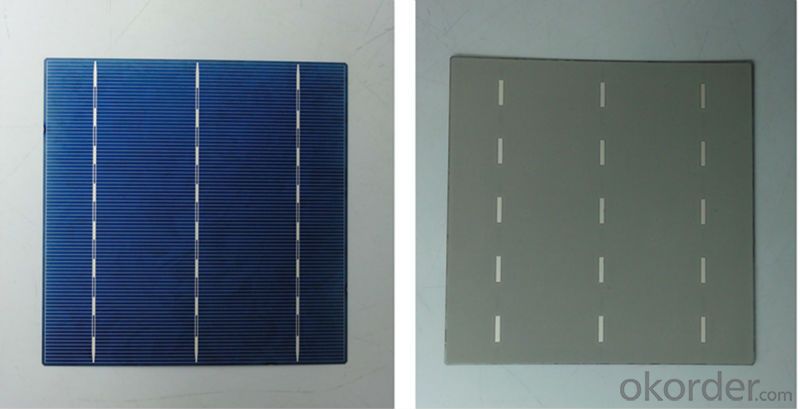
MONO5'(125*125mm)165
Monocrystalline silicon solar cell
Physical Characteristics
Dimension: 125mm×125mm±0.5mm
Diagonal: 165mm±0.5mm
Thickness(Si): 200±20 μm
Front(-) Back(+)
Blue anti-reflecting coating(silicon nitride); Aluminum back surface field;
1.6mmwide bus bars; 2.5mm wide soldering pads;
Distance between bus bars: 61mm . Distance between bus bars :61mm .
Electrical Characteristics
Efficiency(%) | 19.40 | 19.20 | 19.00 | 18.80 | 18.60 | 18.40 | 18.20 | 18.00 | 17.80 | 17.60 | 17.40 | 17.20 |
Pmpp(W) | 2.97 | 2.94 | 2.91 | 2.88 | 2.85 | 2.82 | 2.79 | 2.76 | 2.73 | 2.70 | 2.67 | 2.62 |
Umpp(V) | 0.537 | 0.535 | 0.533 | 0.531 | 0.527 | 0.524 | 0.521 | 0.518 | 0.516 | 0.515 | 0.513 | 0.509 |
Impp(A) | 5.531 | 5.495 | 5.460 | 5.424 | 5.408 | 5.382 | 5.355 | 5.328 | 5.291 | 5.243 | 5.195 | 4.147 |
Uoc(V) | 0.637 | 0.637 | 0.636 | 0.635 | 0.633 | 0.630 | 0.629 | 0.629 | 0.628 | 0.626 | 0.626 | 0.625 |
Isc(A) | 5.888 | 5.876 | 5.862 | 5.848 | 5.839 | 5.826 | 5.809 | 5.791 | 5.779 | 5.756 | 5.293 | 5.144 |

FAQ:
Q:How can i get some sample?
A:Yes , if you want order ,sample is not a problem.
Q:How about your solar panel efficency?
A: Our product efficency around 17.25%~18.25%.
Q:What’s the certificate you have got?
A: we have overall product certificate of ISO9001/ISO14001/CE/TUV/UL
- Q:What is the meaning of the wafer (100), the crystal orientation index or the crystal plane index?Also (1100 and (111) which direction and angle should be cut?
- It's the wrong markIt should be pointed outCrystal growth direction
- Q:How does the efficiency of a solar silicon wafer change with dust accumulation?
- The efficiency of a solar silicon wafer decreases with dust accumulation. Dust on the surface of the wafer blocks sunlight from reaching the silicon cells, reducing the amount of energy that can be converted into electricity. This results in decreased overall efficiency of the solar panel. Regular cleaning and maintenance are important to ensure optimal performance of the solar system.
- Q:What is the typical efficiency degradation rate of a solar silicon wafer over time?
- The typical efficiency degradation rate of a solar silicon wafer over time is around 0.5% to 1% per year.
- Q:What is the role of an interconnect in a solar silicon wafer?
- The role of an interconnect in a solar silicon wafer is to connect individual solar cells together in a series or parallel configuration, allowing for the efficient flow of electricity generated by the cells. It helps to establish electrical connections between the cells, ensuring that the current produced by each cell is combined and collected effectively.
- Q:What is the role of surface recombination on solar silicon wafers?
- The role of surface recombination on solar silicon wafers is to hinder the efficiency of the solar cell by reducing the rate at which charge carriers (electrons and holes) recombine at the surface of the wafer. This phenomenon decreases the overall performance of the solar cell by limiting the amount of generated electricity. Efforts are made to minimize surface recombination through various surface passivation techniques, such as applying anti-reflection coatings or using passivating layers, in order to enhance the efficiency of solar cells.
- Q:What is the efficiency of a solar silicon wafer?
- The efficiency of a solar silicon wafer refers to its ability to convert sunlight into electricity. It is typically measured as a percentage of the incoming sunlight that is successfully converted into usable electrical energy. The efficiency can vary depending on various factors including the quality and composition of the silicon wafer, the manufacturing process, and the environmental conditions. Generally, the efficiency of a solar silicon wafer ranges from around 15% to 25%, with higher quality and more advanced technologies achieving higher efficiencies.
- Q:Is the thickness of solar cell silicon wafer certain? Specifically how much
- 140-230 bar, see the specific requirements, most of the requirements of 200
- Q:What is the average reflectivity of a solar silicon wafer?
- The average reflectivity of a solar silicon wafer is typically around 30%.
- Q:Can solar silicon wafers be used in solar-powered waste management systems?
- Yes, solar silicon wafers can be used in solar-powered waste management systems. These wafers are essential components in solar panels, which can generate electricity from sunlight. By harnessing solar energy, waste management systems can operate efficiently and sustainably, powering various processes such as waste collection, recycling, and treatment.
- Q:How does the temperature affect the performance of a solar silicon wafer?
- The temperature directly affects the performance of a solar silicon wafer. Higher temperatures can cause an increase in resistance within the wafer, leading to a decrease in efficiency and power output. Additionally, excessive heat can accelerate the degradation of the materials used in the wafer, reducing its lifespan. Therefore, maintaining lower temperatures is crucial for optimal performance and longevity of a solar silicon wafer.
1. Manufacturer Overview |
|
|---|---|
| Location | |
| Year Established | |
| Annual Output Value | |
| Main Markets | |
| Company Certifications | |
2. Manufacturer Certificates |
|
|---|---|
| a) Certification Name | |
| Range | |
| Reference | |
| Validity Period | |
3. Manufacturer Capability |
|
|---|---|
| a)Trade Capacity | |
| Nearest Port | |
| Export Percentage | |
| No.of Employees in Trade Department | |
| Language Spoken: | |
| b)Factory Information | |
| Factory Size: | |
| No. of Production Lines | |
| Contract Manufacturing | |
| Product Price Range | |
Send your message to us
Solar Cell High Quality A Grade Cell Polyrystalline 5v 17.8%
- Loading Port:
- Shanghai
- Payment Terms:
- TT OR LC
- Min Order Qty:
- 1000 pc
- Supply Capability:
- 100000 pc/month
OKorder Service Pledge
OKorder Financial Service
Similar products
New products
Hot products
Hot Searches
Related keywords
